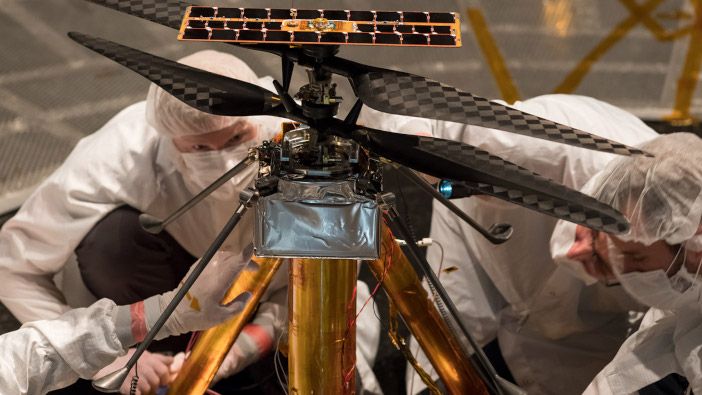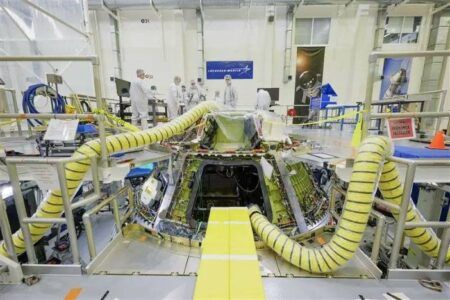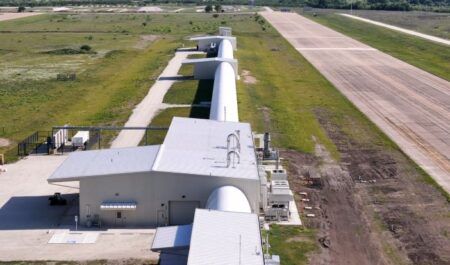Engineers at NASA have successfully tested a helicopter that will operate in Mars inside a space simulator.
Weighing in at no more than 4 lb (1.8kg), the helicopter is a technology demonstration project currently going through the verification process certifying it for Mars.
The majority of the testing was conducted during January 2019. The tests showed how the helicopter will operate on Mars, including how it performs at Mars-like temperatures, which can be as low as -130˚F (-90˚C)
The helicopter is expected to reach the surface of the Red Planet in February 2021, within the belly of the Mars 2020 rover. A few months later, it will be deployed and test flights (up to 90 seconds long) will begin — the first from the surface of another world.
“Gearing up for that first flight on Mars, we have logged over 75 minutes of flying time with an engineering model, which was a close approximation of our helicopter,” said MiMi Aung, project manager for the Mars Helicopter at NASA’s Jet Propulsion Laboratory in Pasadena, California. “But this recent test of the flight model was the real deal. This is our helicopter bound for Mars. We needed to see that it worked as advertised.”
Testing on Earth
While flying helicopters is commonplace here on Earth, flying hundreds of millions of miles away in the thin Martian atmosphere is something else entirely. And creating the right conditions for testing here on Earth presents its own set of challenges.
“The Martian atmosphere is only about one percent the density of Earth’s,” said Aung. “Our test flights could have similar atmospheric density here on Earth — if you put your airfield 100,000ft (30,480m ) up. So you can’t go somewhere and find that. You have to make it.”
Aung and her Mars Helicopter team did just that in JPL’s Space Simulator, a 25ft-wide (7.62m-wide) vacuum chamber. First, the team created a vacuum that sucks out all the nitrogen, oxygen and other gases from the air inside the mammoth cylinder. In their place the team injected carbon dioxide, the chief ingredient of Mars’ atmosphere.
“Getting our helicopter into an extremely thin atmosphere is only part of the challenge,” said Teddy Tzanetos, test conductor for the Mars Helicopter at JPL. “To truly simulate flying on Mars we have to take away two-thirds of Earth’s gravity, because Mars’ gravity is that much weaker.”
Simulating martian gravity
The team accomplished this with a gravity offload system — a motorized lanyard attached to the top of the helicopter to provide an uninterrupted tug equivalent to two-thirds of Earth’s gravity. While the team was understandably concerned with how the helicopter would fare on its first flight, they were equally concerned with how the gravity offload system would perform.
“The gravity offload system performed perfectly, just like our helicopter,” said Tzanetos. “We only required a 2in (5cm) hover to obtain all the data sets needed to confirm that our Mars helicopter flies autonomously as designed in a thin Mars-like atmosphere; there was no need to go higher. It was a heck of a first flight.”
The Mars Helicopter’s first flight was followed up by a second in the vacuum chamber the following day. Logging a grand total of one minute of flight time at an altitude of 2in (5cm), more than 1,500 individual pieces of carbon fiber, flight-grade aluminum, silicon, copper, foil and foam have proven that they can work together as a cohesive unit.
“The next time we fly, we fly on Mars,” said Aung. “Watching our helicopter go through its paces in the chamber, I couldn’t help but think about the historic vehicles that have been in there in the past. The chamber hosted missions from the Ranger Moon probes to the Voyagers to Cassini, and every Mars rover ever flown. To see our helicopter in there reminded me we are on our way to making a little chunk of space history as well.”
The Mars Helicopter project at JPL in Pasadena, California, manages the helicopter development for the Science Mission Directorate at NASA Headquarters in Washington.
The Mars Helicopter will launch as a technology demonstrator with the Mars 2020 rover on a United Launch Alliance Atlas V rocket in July 2020 from Space Launch Complex 41 at Cape Canaveral Air Force Station, Florida. It is expected to reach Mars in February 2021.
The 2020 rover will conduct geological assessments of its landing site on Mars, determine the habitability of the environment, search for signs of ancient Martian life, and assess natural resources and hazards for future human explorers. Scientists will use the instruments aboard the rover to identify and collect samples of rock and soil, encase them in sealed tubes, and leave them on the planet’s surface for potential return to Earth on a future Mars mission.
The Mars 2020 project at JPL in Pasadena, California, manages rover development for the Science Mission Directorate at NASA Headquarters. NASA’s Launch Services Program, based at the agency’s Kennedy Space Center in Florida, is responsible for launch management.





